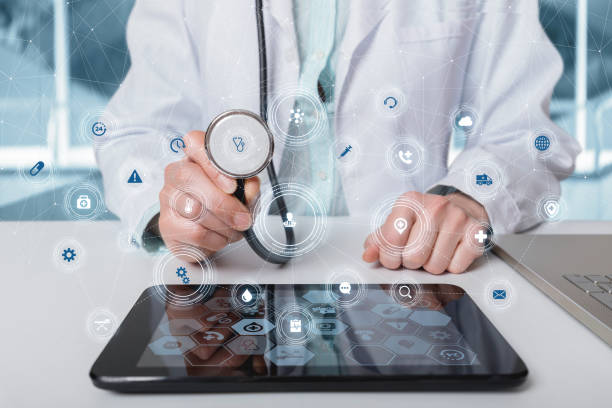While some remote patient monitoring (RPM) companies provide a comprehensive remote patient monitoring platforms, others focus solely on supplying the remote patient monitoring devices to facilitate remote patient care. The article explores myriad features that a robust RPM platform can provide. We also describe platforms extending their services to shipping and fulfillment, device provisioning, and device upkeep for enhanced convenience.
What is a Remote Patient Monitoring Platform?
A remote patient monitoring platform is a conduit between healthcare providers and patients, bridging the gap between in-person visits. As an intermediary, an RPM platform utilizes a variety of medical devices, such as devices to measure blood pressure or weight, and communication tools to collect and transmit patient data to healthcare professionals for assessment and intervention. The advantages of remote patient monitoring are manifold, from chronic disease management to post-surgery recovery, all achievable without the constraints of physical presence at a medical facility.
How Does a Remote Patient Monitoring Platform Work?
This section explores how a remote patient monitoring platform works. We unveil how vital health data is collected, transmitted, analyzed, and utilized to enable timely interventions. Here’s how a typical RPM platform works.
First, patients use remote patient monitoring devices to collect blood pressure, heart rate, blood glucose levels, oxygen saturation, weight, and more. Second, the collected data is transmitted securely to the RPM platform through cellular networks, Bluetooth or Wi-Fi. Third, the RPM platform analyzes the health data to identify anomalies or trends. Finally, healthcare providers can set up thresholds and alerts to notify them if patient data falls outside the normal range, indicating a potential health issue.
Healthcare Provider Intervention
If the remote patient monitoring platform detects concerning data, healthcare providers are alerted. They can review the data and make informed decisions about necessary interventions, such as adjusting medications, providing advice, or scheduling an in-person visit.
RPM Platform Solutions
Remote patient monitoring companies differ in the technology they use, the devices they support, and the level of data integration with electronic health records systems. In addition, the comprehensiveness of analytics and reporting tools and the user experience for patients and healthcare providers vary. Certain RPM companies offer platforms with extended services, including shipping and fulfillment. We will explain the benefits of shipping and fulfillment services in the next section.
Shipping and Fulfillment Services
Shipping and fulfillment services simplify onboarding and ensure the seamless delivery of medical devices and supplies to healthcare organizations or patients’ homes. This aspect enhances the overall RPM experience.
Device Provisioning and Distribution
An RPM platform with shipping and fulfillment services allows for providing and distributing medical devices to patients, thus eliminating the need for patients to visit a physical clinic to pick up the devices. RPM device fulfillment makes RPM convenient for patients. It is especially beneficial for patients with mobility challenges or those living in rural areas.
Patient Onboarding
When patients are prescribed remote monitoring as part of their care plan, the RPM platform can handle the logistics of sending the required devices directly to the patient’s doorstep. This simplifies the onboarding process, ensuring patients have the necessary tools to monitor their health without delays.
Device Maintenance and Replacements
FDA-cleared medical devices may require maintenance or replacements over time. RPM platforms with shipping and fulfillment capabilities can facilitate shipping replacement devices as needed. This proactive approach minimizes monitoring disruptions and reduces patients’ burden of sourcing replacement parts. Finally, some RPM platforms also run regular device and security updates.
RPM Platform & Reducing Administrative Burden
Healthcare providers benefit when choosing a remote patient monitoring platform with built-in shipping and fulfillment services. Doing so effectively reduces the administrative workload and workflow associated with coordinating device distribution and logistics. Furthermore, healthcare teams focus more on data analysis, patient communication, and making informed medical decisions.
Depending on the patient’s medical condition and monitoring requirements, the RPM platform can be customized to ship supplies to each patient. This ensures that patients receive only the medical equipment relevant to their specific health needs, optimizing resource use. From device provisioning to data analysis, healthcare providers can rely on a single RPM platform to manage all aspects of remote monitoring.
The Benefits of Remote Patient Monitoring
The following section delves into the many benefits of remote patient monitoring and its impact on healthcare delivery and patient experiences.
- Improved Access to Care: Patients gain timely medical attention and monitoring without frequent in-person visits, a boon for remote or underserved areas.
- Early Detection and Intervention: Healthcare providers catch issues early, curbing escalation and lowering hospitalizations.
- Chronic Disease Management: Conditions like diabetes find better management, boosting adherence and patient control.
- Reduced Healthcare Costs: By averting complications and hospital stays, savings accrue for patients and healthcare systems.
- Patient Empowerment: Personalized insights and education engage patients in self-care and progress tracking.
- Real-Time Monitoring: Providers access instant data, refining decisions, and personalized treatments.
- Data-Driven Care: Beyond individuals, platform data aids research, population health, and care enhancement.
- Aging Population: Remote monitoring aids elderly care at home, upholding quality of life.
RPM Platform Key Points
In closing, this robust RPM platform harmonizes conventional healthcare with modern technology, propelling patient outcomes and healthcare efficiency. Additionally, advanced shipping and fulfillment services enhance patient satisfaction, convenience, engagement, and accessibility. Furthermore, these platforms contribute to a more seamless and practical RPM experience by streamlining the device provisioning and maintenance.
The Tenovi remote patient monitoring platform incorporates functionalities focused on security, accuracy, boosting growth, fulfillment, and technical support. Are you part of a chronic care management, telehealth, RPM services, or software company searching for an RPM platform for your partners? Schedule your consultation and demo today.


